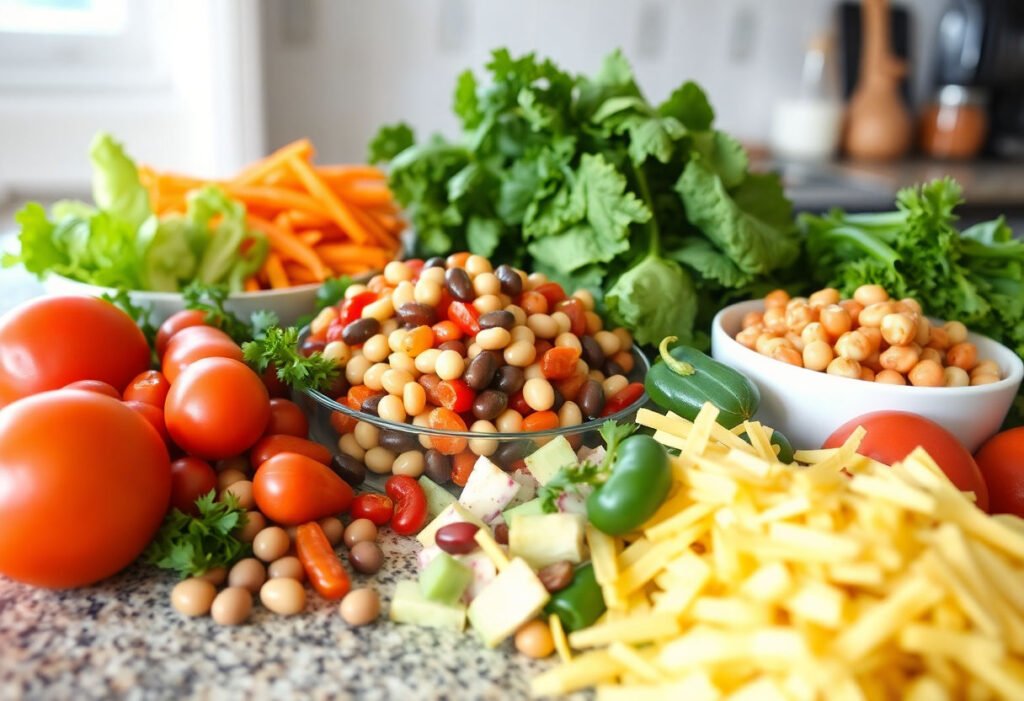Creating a bean salad that is both nutritious and time-efficient is achievable with the right techniques and planning. This article delves into essential strategies for efficient meal prep, allowing you to enjoy wholesome meals while saving valuable time. You’ll learn how to select the best beans and fresh produce, craft a balanced dressing, and store your salads properly to maintain freshness. Additionally, we will explore ways to incorporate proteins and grains, adjust portions optimally, and present your dish attractively. Prepare to transform your kitchen habits and enhance your culinary experience, making bean salad meal prep a seamless part of your routine.
Key Takeaways
- Efficient meal prep with bean salad enhances nutrition and saves time, ensuring balanced meals throughout the week.
- Selecting the right beans and fresh ingredients is crucial for optimizing flavor and nutritional benefits in your salad.
- Proper preparation and seasoning of beans elevate the taste and texture, contributing to a delightful eating experience.
- Incorporating a variety of fresh vegetables, herbs, and a balanced dressing provides a harmonious blend of flavors and nutrients.
- Effective storage techniques maintain freshness and prevent spoilage, maximizing the longevity of your prepared meals.
Choosing the Right Beans
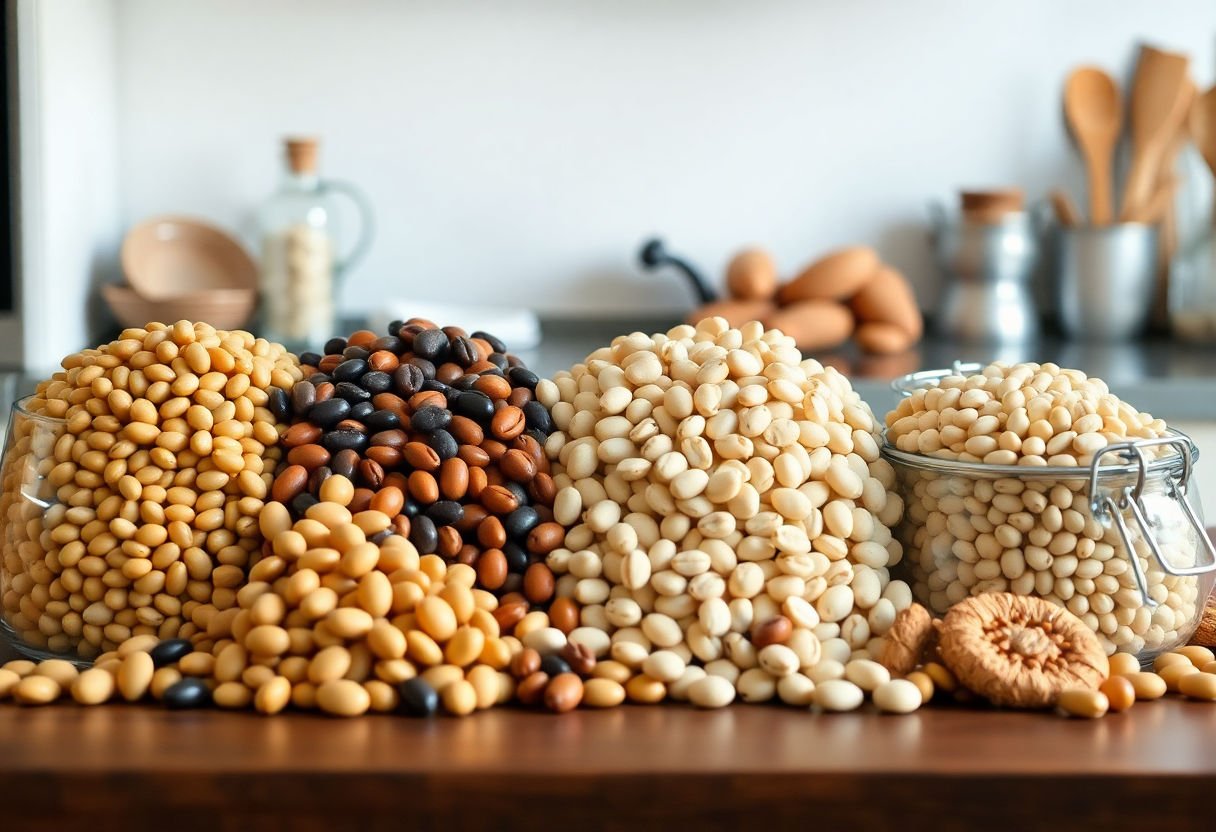
When crafting a delicious and nutritious bean salad, selecting the right beans is essential for both flavor and health benefits. Beans are a powerhouse of nutrients, providing a rich source of protein, fiber, and essential vitamins. Here’s a guide to choosing the best ones for your salad:
-
Variety Matters: Incorporating different types of beans not only enhances the taste but also the nutritional profile of your salad. Consider the following options:
- Kidney Beans: Known for their robust texture and slightly sweet flavor.
- Chickpeas: Offer a subtle nutty taste and are packed with protein.
- Black Beans: Provide a creamy texture and a rich taste, ideal for a southwestern twist.
- Cannellini Beans: These have a mild flavor and smooth texture that complements many ingredients.
-
Nutritional Benefits: Each type of bean brings unique health benefits:
- Fiber Content: All beans are high in dietary fiber, important for digestive health and satiety.
- Protein Powerhouse: Beans are an excellent plant-based protein source, helping to maintain muscle health.
- Vitamins and Minerals: They are packed with essential nutrients like folate, iron, and potassium.
-
Canned vs. Dried Beans: Both have their merits. Canned beans are convenient and time-saving, already pre-cooked and ready to use. To reduce sodium content, opt for low-sodium varieties or rinse them thoroughly. Dried beans, while requiring soaking and cooking, offer a deeper flavor and firmer texture.
By selecting the right combination of beans, you can ensure your salad is flavorful, nutritious, and satisfying.
Preparing Beans Perfectly

To achieve perfectly prepared beans for your salad, start by selecting high-quality dried beans. The first crucial step in preparing beans is soaking. Soaking beans in water overnight helps to reduce cooking time and improve their digestibility. For quick soaking, bring the beans to a boil, let them simmer for a couple of minutes, and then remove them from the heat, allowing them to sit for an hour.
Once soaked, it’s time to boil them to perfection. Use fresh water, ensuring the beans are covered by at least two inches. Bringing beans to a gentle boil and then reducing to a simmer helps them cook evenly, without the risk of bursting. Most beans require about 1 to 1.5 hours to cook, depending on their size and age. Regularly check for tenderness to avoid overcooking; beans should be soft but not mushy.
As the beans cook, consider seasoning them to enhance their natural flavor. Add salt during the last few minutes of cooking to prevent toughening. Incorporate aromatic herbs like bay leaves or thyme and spices such as cumin or coriander to imbue the beans with a subtle yet delightful aroma.
Embrace these simple yet effective techniques to ensure your beans contribute not only to the nutritional value of your salad but also to its overall flavor profile, elevating your dish from mundane to extraordinary.
Incorporating Fresh Vegetables and Herbs
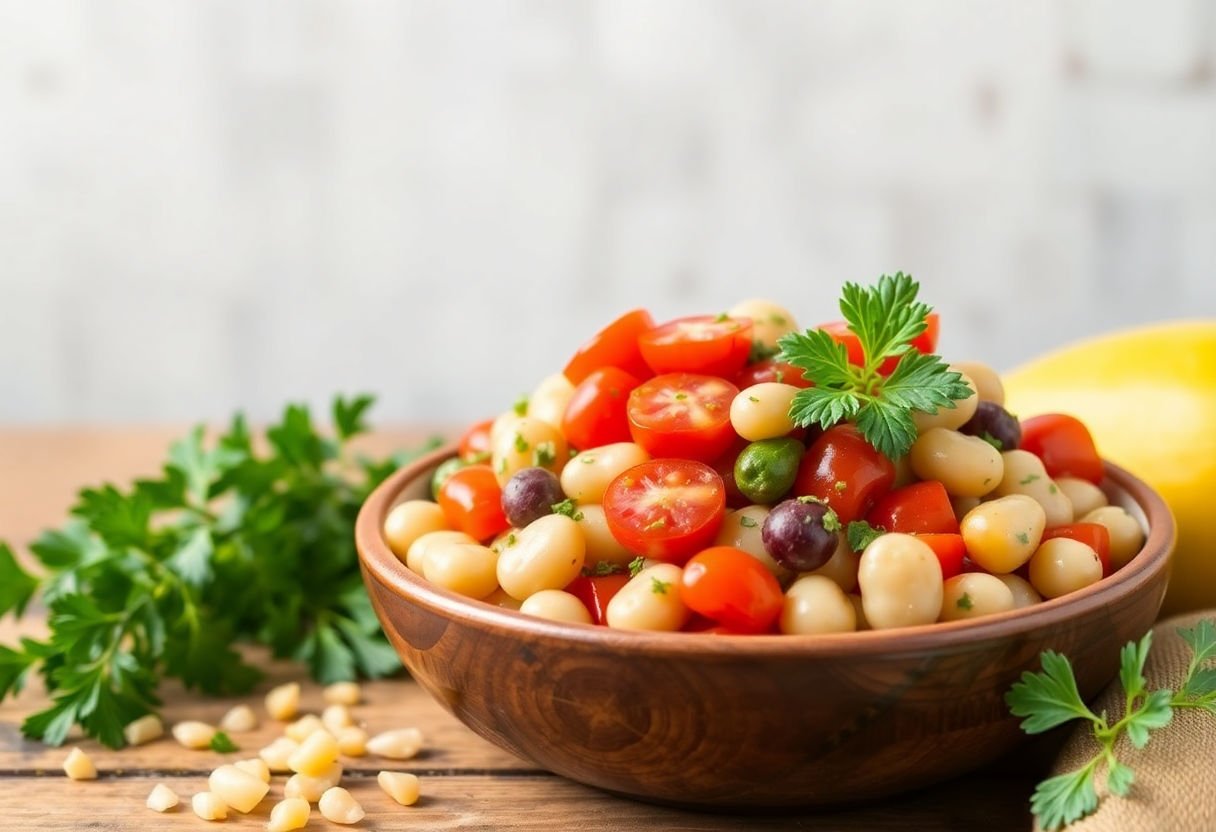
Incorporating fresh vegetables and herbs into your bean salad is essential for enhancing both flavor and nutrition. When selecting the best vegetables, prioritize those that add diversity in color, texture, and taste. Common choices include:
- Bell Peppers: Their crisp texture and sweet flavor complement the creaminess of beans.
- Cucumbers: Add a refreshing crunch.
- Tomatoes: Provide juiciness and a slight acidity that balances bean flavors.
Herbs are vital for infusing distinct flavors and aromas into your salad. Fresh herbs, unlike dried ones, offer a vibrant taste that can transform your bean salad from bland to exciting. Consider:
- Basil: Adds a sweet, aromatic flavor.
- Cilantro: Introduces a fresh, citrusy note especially suitable for salads with a Latin twist.
- Parsley: Its mild peppery flavor enhances overall balance without overpowering other ingredients.
When preparing your vegetables, ensure they are washed and dried thoroughly to maintain their crispness. Dice them uniformly to ensure even flavor distribution in each bite. As for herbs, gently chop them to release the oils without bruising the leaves, which could result in a bitter taste.
Additionally, vegetables and herbs not only enhance flavor but significantly boost the nutritional profile of your meal. They are rich in vitamins, antioxidants, and fiber, crucial for maintaining a healthy diet. By thoughtfully selecting a mix of fresh produce, you not only elevate the taste of your bean salad but also its health benefits, making it a more wholesome meal prep option.
Creating a Balanced Dressing
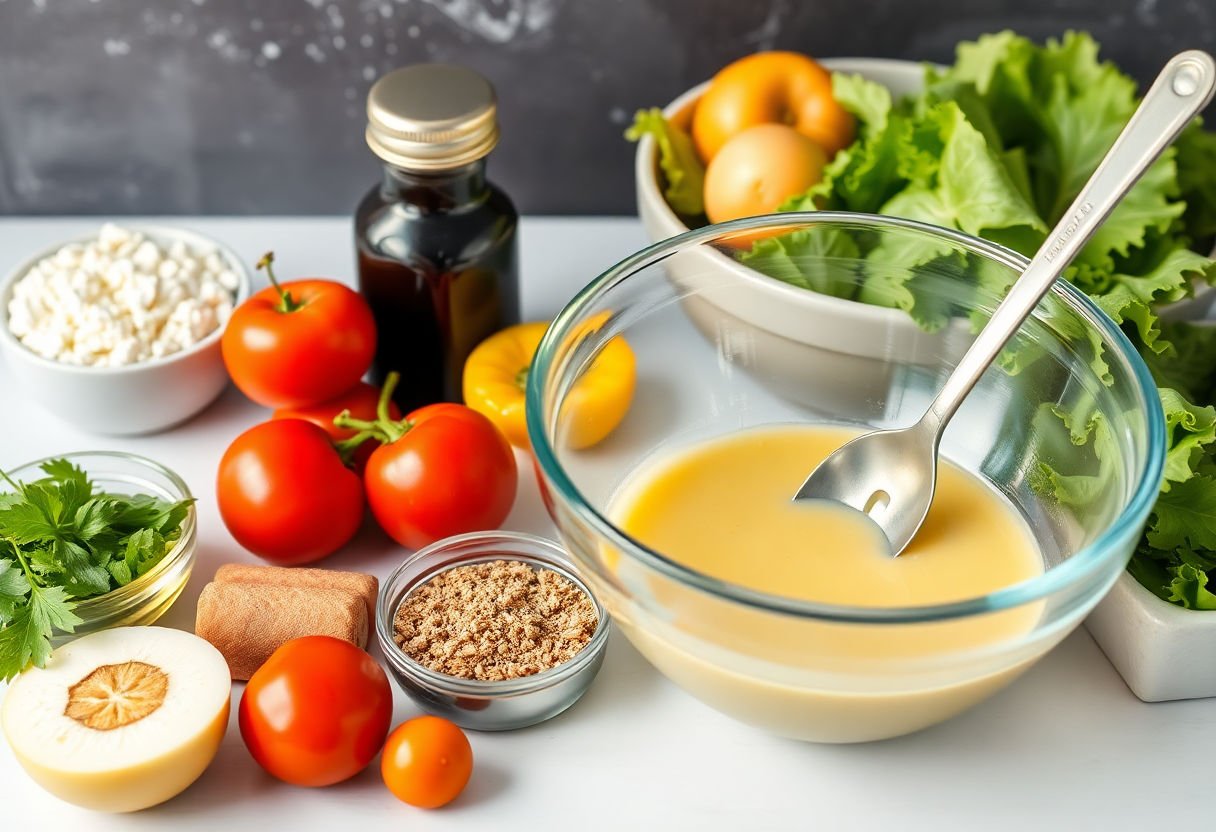
Creating a dressing for bean salad requires a delicate balance between taste and nutritional benefits. To craft the perfect dressing, consider incorporating these elements:
-
Acid: Opt for a mild acid like lemon juice or apple cider vinegar. These not only enhance flavor but also aid in digestion and nutrient absorption. As a rule of thumb, use about one tablespoon of acid per two cups of salad.
-
Oil: Choose heart-healthy oils such as extra virgin olive oil or avocado oil. These oils provide essential fatty acids that improve heart health. Generally, a 1:1 ratio with the acid will maintain a balanced flavor.
-
Sweetness: Adding a touch of honey or maple syrup can counteract the acidity, providing a well-rounded taste. Limit sweetness to a teaspoon per batch to keep it healthy.
-
Seasonings: Consider using Dijon mustard, garlic, or fresh herbs like basil or cilantro for depth. Freshly ground black pepper and sea salt can also elevate the dressing without overpowering the salad.
Experiment with combinations, such as a lemon-garlic vinaigrette or a balsamic-herb blend, to find your preferred taste profile. Consider preparing the dressing in advance and refrigerating it to blend flavors optimally. Remember, a balanced dressing not only enhances the salad’s flavor but also boosts its health benefits, making it an essential component of an efficient meal prep strategy.
Efficient Storage and Preservation
Storing your bean salad efficiently is essential to maintaining its freshness and ensuring that it remains a safe and nutritious meal option throughout the week. Begin by using airtight containers, preferably glass, to prevent any external odors from impacting the salad’s flavors. Glass containers also help maintain the salad’s original taste and texture, as they do not absorb colors or odors like plastic.
To extend the salad’s shelf life, keep it in the refrigerator at temperatures below 40°F (4°C). This helps prevent the growth of bacteria, reducing the risk of spoilage. Portion out your bean salad into individual servings, making them easy to grab and go while also limiting exposure to air each time you open the container.
Consider storing the dressing separately. By doing so, you prevent the salad from becoming soggy. Simply add the dressing before consumption to ensure maximum freshness and crunch. A well-preserved salad retains its nutritional value while delighting the palate with each bite.
For longer preservation, you may opt to freeze certain components of the salad such as the seasoned beans. Freezing them in individual portions allows you to thaw only what you need. However, it’s important to note that not all ingredients are freezer-friendly; fresh vegetables and herbs, for example, might lose their crispness.
Lastly, label your containers with the preparation date to help monitor freshness over time. Efficient preservation not only maintains quality but also contributes significantly to reducing food waste.
Adjusting Portions for Meal Prep
To ensure your bean salad meal prep meets your dietary needs and demands of family size, it’s crucial to adjust portions effectively. When planning your portions, consider both nutritional balance and serving size.
Estimating Portion Sizes
Start by deciding how many servings you need. A general guideline is:
- Single serving: Approximately 1 cup of bean salad.
- Family meal: Multiply the single serving by the number of family members, adjusting for appetite variations.
Consider incorporating side dishes if preparing for a large family gathering, which allows you to reduce the volume of your bean salad portions without compromising on satisfaction.
Customizing Based on Dietary Needs
Tailor the size of each portion to specific dietary requirements:
- Protein-rich diets: Increase the bean and possibly protein additives, like grilled chicken or tofu, for more substantial servings.
- Carbohydrate control: Adjust the proportion of beans in relation to other low-carb vegetables like leafy greens or cucumbers.
- High-fiber needs: Opt for beans high in fiber such as black beans or chickpeas, and slightly increase the portion for these ingredients.
Batch Cooking and Storage Considerations
Batch cooking can be a time-saver. Prepare a large amount and divide it into smaller storage containers. This method not only aids in maintaining freshness but also enforces portion control. Use clear containers to easily identify contents and manage your servings more effectively.
Adjusting your bean salad portions thoughtfully ensures you maintain a nutritious meal prep regimen while accommodating the varied needs of your household or personal diet.
Incorporating Protein and Grains
To make your bean salad more satiating and nutritionally complete, integrating protein-rich ingredients and grains is essential. This approach not only enhances flavor but also boosts the nutritional profile of your meal, making it suitable for a balanced diet.
Start with adding high-quality proteins. Consider options like cubed feta cheese, shredded chicken, or boiled eggs, which blend well with the creamy texture of beans. If you’re seeking plant-based alternatives, tofu, tempeh, or toasted nuts like almonds or walnuts are excellent choices, offering both protein and a satisfying crunch.
Grains also play a vital role in amplifying the nutritional value of your salad. Quinoa, for instance, is an exceptional choice as it’s not only a source of complete protein but also adds a delightful nutty flavor. Alternatively, brown rice or farro can introduce a wholesome texture and fiber, keeping you fuller for longer.
For convenience, consider preparing these proteins and grains in bulk. This ensures you always have them ready to toss into your salad, saving time during meal prep. To maintain freshness, store cooked grains and proteins separately in airtight containers and combine them with your bean salad only when ready to consume.
By thoughtfully incorporating proteins and grains, you’re not just enhancing the taste but also crafting a well-rounded dish that caters to both nutritional needs and culinary delight.
Tips for Serving and Presentation
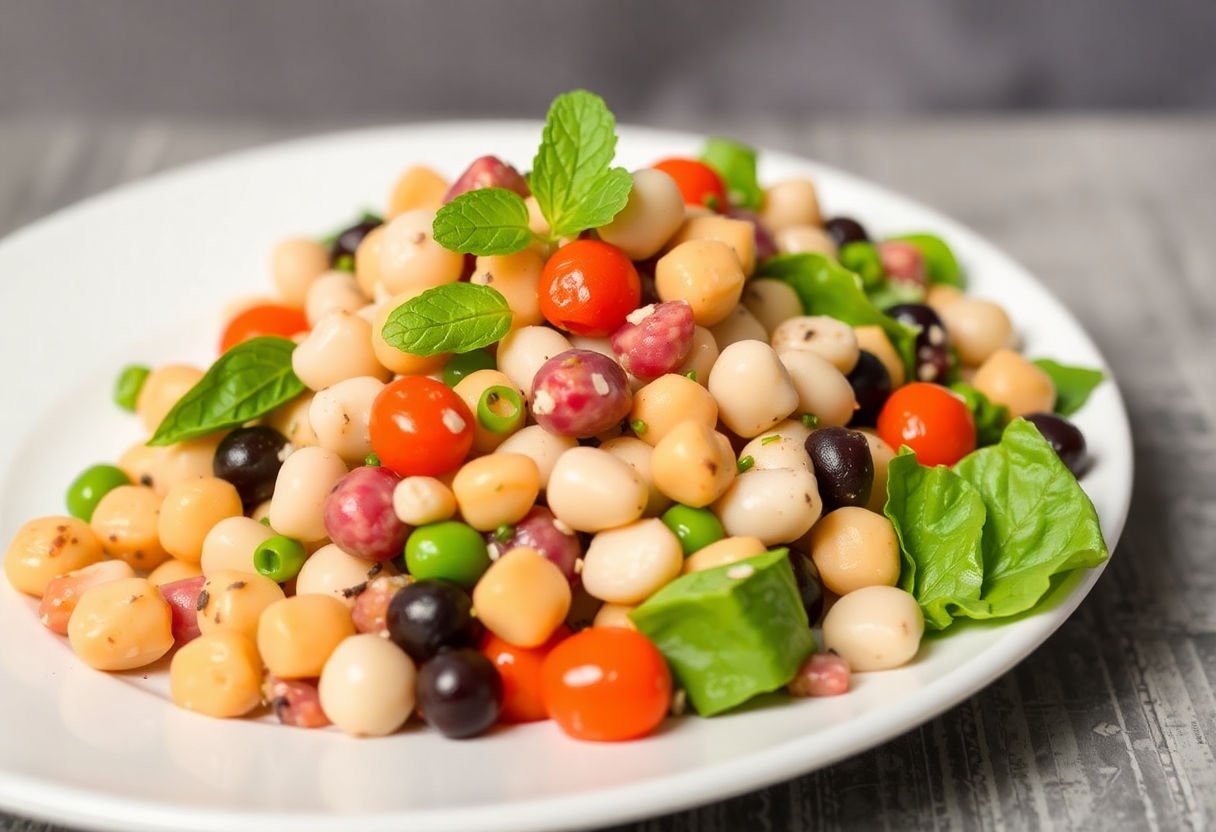
Enhancing the visual appeal of your bean salad can elevate the dining experience. Here are several tips to ensure your salad is not only delicious but also beautifully presented:
-
Choose a Vibrant Color Palette: Incorporate a variety of colorful beans and fresh vegetables. Opt for red kidney beans, bright green edamame, and golden chickpeas. Adding vegetables like bell peppers, cherry tomatoes, and red onions can create a visually stunning salad that captures attention.
-
Utilize Contrasting Textures: Enhance the texture of the dish by combining crunchy vegetables like cucumbers with creamy avocado or feta cheese. This contrast in texture not only adds to the sensory experience but also makes the salad more enjoyable to eat.
-
Consider the Presentation Vessel: Select the right dish for serving. A large, flat salad bowl or a wide platter allows you to spread out the ingredients, showcasing the salad’s variety and color. Glass bowls are particularly effective in highlighting the layers of the salad.
-
Add a Garnish for Elegance: Sprinkle fresh herbs like cilantro or parsley over the top for a touch of elegance. A light drizzle of olive oil or balsamic reduction can also enhance the presentation and flavor profile.
-
Portion with Precision: When serving, use a rounded spoon to create neat, consistent portions. For individual servings, consider layering the salad in mason jars or clear cups for a modern touch.
Following these tips can make each serving of your bean salad a feast for both the eyes and the palate, ensuring a memorable meal prep experience for you and your guests.
Conclusion
In conclusion, mastering bean salad meal prep not only saves valuable time but also enhances nutritional quality and meal enjoyment. By selecting the right beans, preparing them perfectly, and incorporating fresh vegetables, herbs, and balanced dressings, you lay the foundation for delicious, nutritious meals. Efficient storage and careful portioning further enhance meal planning. As you explore adding proteins and grains, you create a more satisfying and wholesome dish. Embrace these strategies for an effective approach to meal prep, ensuring healthy, convenient options are always within reach, supporting a more organized and health-oriented lifestyle.
Frequently Asked Questions
Can I substitute different types of beans in my salad?
Yes, you can substitute different types of beans based on your preference or dietary needs. Black beans, chickpeas, and kidney beans are all excellent options, each bringing unique flavors and nutritional benefits to your salad.
How long can I store bean salad in the refrigerator?
Typically, bean salad can be stored in the refrigerator for up to three to five days if kept in an airtight container. To maintain freshness, ensure that any dressing is added shortly before serving.
Can I use canned beans instead of dried beans?
Absolutely, canned beans are a convenient alternative that can save time. However, make sure to rinse them thoroughly to remove excess sodium and enhance their flavor.
What are some protein-rich additions I can include?
Incorporating protein such as grilled chicken, tofu, or boiled eggs can make your salad more filling and nourishing. These additions are easy to prepare and pair well with the flavors of bean salad.
How can I prevent my salad from becoming soggy?
To prevent sogginess, consider storing the dressing separately and adding it just before consumption. Additionally, including vegetables that are firm and less water-retentive, such as bell peppers or carrots, can help maintain the salad’s crispness.
